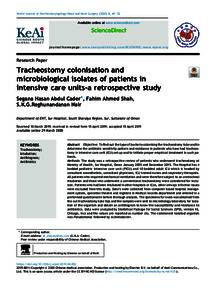وثيقة
Tracheostomy colonisation and microbiological isolates of patients in intensive care units-a retrospective study.
المعرف
DOI: 10.1016/j.wjorl.2019.04.002
المصدر
World Journal of Otorhinolaryngology - Head and Neck Surgery. v. 6, 1, p. 49-52
المساهمون
Shah, Fahim Ahmed., مؤلف
الدولة
China
الناشر
KeAi Communications Co.
ميلادي
2020-03-01
اللغة
الأنجليزية
الملخص الإنجليزي
Objective: To find out the type of bacteria colonising the tracheostomy tube and to determine the antibiotic sensitivity pattern and resistance in patients who have had tracheostomy in intensive care unit (ICU) set up and to initiate proper empirical treatment in such patients. Methods: The study was a retrospective review of patients who underwent tracheostomy at Ministry of Health, Sur Hospital, Oman January 2005 and December 2015. The Hospital has 4 bedded pediatric intensive care unit (PICU) and 10 bedded adult ICU which is headed by consultant anaesthetists, consultant physicians, ICU trained nurses and respiratory therapists. All patients who required mechanical ventilation and were therefore subject to an orotracheal intubation and those who underwent a conventional tracheostomy were considered for inclusion. Patients who had been intubated in other hospitals or ICUs, other airways infection issues were excluded from this study. Data's were collected from computer based hospital management system, operation theatre and registers in Medical records department and entered in a preformed questionnaire before thorough analysis. The specimens for swab was obtained from the cut tracheostomy tube tips and the samples were sent to microbiology laboratory for isolation of the organism and obtain an antibiogram to know the susceptibility and resistance to antibiotics. Data were analyzed by Statistical Package for Social Sciences (SPSS, version 16, Chicago, Inc) and the values are reported as number (%). The commonest isolated organism was Pseudomonas followed by Acinetobacter. Results: During the ten year retrospective study, there were 108 patients included in our study with 56 males and 51 females. Fourteen different microorganisms were isolated during our study which included Pseudomonas aeruginosa (n = 39), Acinetobacter baumanii (n = 28), Klebsiella (n = 10) and coagulase negative staphylococcus (n = 6). The most commonest organisms in both genders was Pseudomonas aeruginosa closely followed by Acinetobacter baumanii. In children under age of 12, it was Pseudomonas aeruginosa and in adults the impending organism was Acinetobacter baumanii. In terms of antiobiograms, 89% of Acinetobacter, 38% of Staphylococcus aureus, 37% of Klebsiella and 54% of Proteus mirabilis were resistant to ciprofloxacin. These organisms were resistant to ceftazidime in 97%, 83%, 89% and 57% of the cases, respectively and resistant to imipenem in 7.4%, 18.2%, 1.8% and 8.1%. Conclusions: In summary, this study presents the most common microorganisms colonized from tracheostomy of hospitalized patients and their pattern of antibiotic resistance. As our study showed, Pseudomonas is the most common microorganism isolated from tracheostomy tube. Ciprofloxacin was also the most prevalent antibiotic revealing resistant pattern. Moreover, most of the microorganisms were sensitive to imipenem and pipracillin-tazobactam.
ISSN
2095-8811
قالب العنصر
مقالات الدوريات

